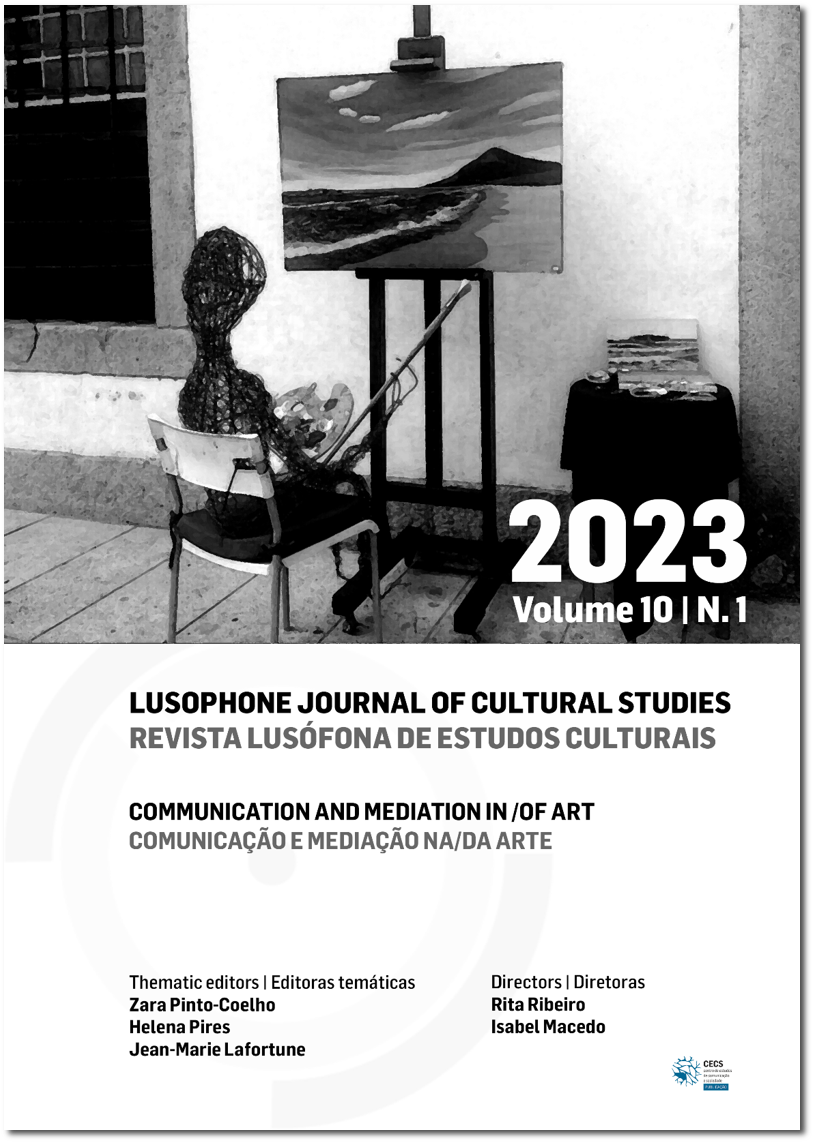Audience-Foyer: Dialogue and Public Formation with Dramatic Reading in Performing Arts
DOI:
https://doi.org/10.21814/rlec.4429Keywords:
communication, theatre, audience-foyer, dramatic reading, public formationAbstract
The object of this article, whose research adopts a qualitative approach, takes an interdisciplinary path and has an applied nature, is the potential formation of theatre audiences seeking to turn them into virtually lasting public through artistic and communication practices in the field of performing arts called "audience-foyer" and "dramatic reading". At the theoretical and methodological levels, with descriptive and interpretative purposes, it draws from the model of studies of communication as dialogue, typical of the Latin American thinking in communication, from a public relations perspective, in which the practice of conversation and commentary, between the logic of organisational communication and the affection of art, emerges for the production of the social bond between artists and audience/public. This case study is about Teatro Mosaico (Brazil), in the staging of two dramatic texts: o Prólogo (Prologue), by director Sandro Lucose (2005), and A Caravana da Ilusão (The Illusion’s Caravan), by director Alcione Araújo (2000), where comedy and drama, in the same play, made the paths of a theatre company bifurcate.
Downloads
References
Alfaro, R. M. (1988). Participación... Para quê? Un enfoque político de la participación en la comunicación popular. Diálogos de la Comunicación, (22), 1–52.
Andrade, T. de. A. (1989). Psicossociologia das relações públicas. Edições Loyola.
Araújo, A. (2000), A Caravana da ilusão: Delírio em um ato. Civilização Brasileira.
Araújo, M. (2011). O vai e vem dos conceitos, de categoría analítica a categoría nativa ou vice-versa: O caso do sincretismo. Debates do NER, (19), 121–140. https://doi.org/10.22456/1982-8136.19025
Blumer, H. (1978). A massa, o público e a opinião pública (M. Sergio, Trad.). In G. Cohn (Ed.), Comunicação e Indústria Cultural (pp. 177-186). Companhia Editora Nacional (Trabalho original publicado em 1946)
Bordenave, J. D., & Carvalho, H. M. de (1987). Comunicação e planejamento. Paz e Terra.
Bourdieu, P. (2004). A economia das trocas simbólicas (S. Miceli, S. de A. Prado, S. Miceli, & W. C. Vieira, Trads). Perspectiva.
Celestino, P., & Martins, F. (2018). Uma quimera quase real: A burleta O Mambembe de Arthur Azevedo e José Piza. Pós, 8(15), 8–36. https://periodicos.ufmg.br/index.php/revistapos/article/view/15602
Demo, P. (2014). Metodologia científica em ciências sociais. Atlas.
França, F. (2004). Públicos: Como identificá-los em uma visão estratégica. Difusão Editora.
Freire, P. (1977). Extensão ou comunicação? Paz e Terra.
Giácomo, C. (1993). Tudo acaba em festa: Evento, líder de opinião, motivação e público. Scritta Editorial.
Gushiken, Y. (2006). Dialogismo: Emergência do Pensamento Latino-americano em Comunicação. Comunicação, Mídia e Consumo, 3(8), 73–91. https://doi.org/10.18568/cmc.v3i8.81
Gushiken, Y. (2008). Estudos em Relações Públicas e o Pensamento Latino-americano em Comunicação. In: Moura, C. P. de. História das Relações Públicas: Fragmentos da história de uma área. EdiPURCS. Retirado de: https://ebooks.pucrs.edipucrs/acessolivre/livros/historiarespdf
Kothe, F. R. (1981). Literatura e sistemas intersemióticos. Cortez Editora/Autores Associados.
Lima, V. A. de (2001). Mídia: Teoria e política. Editora Fundação Perseu Abramo.
Lopes. M. I. V. de. (2003). Pesquisa em comunicação. Edições Loyola.
Lucose, S. (2005). Prólogo à caravana da ilusão. (no prelo).
Mauss, M. (2003). Sociologia e antropologia (P. Neves, Trad.). Cosac Naif.
Minayo, M. C. S. (2009). Ciência, técnica e arte: O desafio da pesquisa social. In M. C. de S. Minayo (Ed.), Pesquisa social: Teoria, método e criatividade (pp. 9–29). Vozes.
Pasquali. A. (1973). Sociologia e Comunicação. Vozes.
Pereira, R. (2000). Texto de apresentação. In Programa do 9º Panorama RioArte de Dança 2000 (p. 12). Secretaria Municipal de Cultura do Rio de Janeiro; RioArte.
Sodré, M. (2001). O objeto da comunicação é a vinculação social. PCLA, 3(1), 1–6. Retirado de: http://www2.metodista.br/unesco/PCLA/revista9/entrevista%209-1.htm
Vieira, C. (2014). A leitura dramatizada como atividade pedagógica e teatral. In J. D. Pereira, M. F. Vieites, & M. de S. Lopes (Eds.), As artes na educação (pp. 233–238). Intervenção.
Downloads
Published
How to Cite
Issue
Section
License
Copyright (c) 2023 Yuji Gushiken

This work is licensed under a Creative Commons Attribution 4.0 International License.
Authors own the copyright, providing the journal with the right of first publication. The work is licensed under a Creative Commons - Atribuição 4.0 Internacional License.












